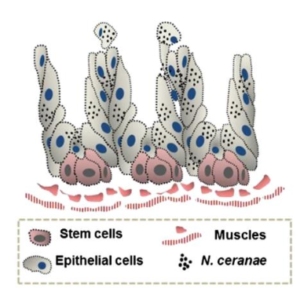Nosema infection threatens millions of honeybee colonies worldwide. Direct-Fed Microbials (DFM), also called probiotics, help bees overcome Nosema infection.


Fumagillin, a potent antibiotic isolated from Aspergillus niger, and previously used to treat Nosema infections, became unavailable to beekeepers in 2018, due to the manufacturer supply problem. Fumagillin mode of action is through binding to methionine amino peptidase type 2 (MetAP-2), essential enzyme found ubiquitously in all organisms, including honeybees and humans. This mode of action accounts for great toxicity associated with fumagillin therapeutic use and concerns about safety of beekeeper exposure to this antibiotic (van den Heever et al., 2014). Emblematic of the negative consequences associated with prophylactic use of fumagillin is its negative effect on insects’ reproductive success (Dickel et al., 2016). Moreover, the current application protocol for fumagillin does not lower Nosema infection incidence in bees, and may exacerbate Nosema infection (Huang et al., 2013). Therefore, a new approach is necessary to prevent and treat honeybee Nosema infections.
Honeybee gut microbiome is essential for weight gain, digestion, longevity and immunocompetence of all honeybee castes (Raymann et al, PLOS, 2017). Direct-Fed Microbials (DFM) supplement beneficial gut microorganisms and further promote honeybee weight gain, digestion and immunocompetence. These benefits translate to the field with supplementation of SuperDFM-HoneyBee on the colony and apiary levels.
Several studies showed
that oral DFM supplementation provides
both prophylactic and curative benefits to honeybees exposed to Nosema (Baffoni et al., 2016; El Khoury
et al., 2018). Microbiome also plays a role in susceptibility to infection and treatment
outlook. The mechanism underlying these results remained enigmatic until
recently.


Honeybee gut microbiome stimulates insulin-like signaling (IIS) pathway, increasing IIS gene expression and weight gain (Zheng et al., PNAS, 2017). IIS pathway plays our within the epithelial cells lining the gut. A subset of these cells, called stem cells, are responsible for epithelium renewal. Importantly, Nosema infection suppresses gut epithelium renewal, while IIS pathway promotes intestinal stem cell proliferation (Panek et al., JIP, 2018). By upregulating IIS, gut microbiome and exogenous microbes like DFM stimulate gut renewal and intestinal stem cell proliferation, utilizing existing mechanisms to counteract the degenerative effects of Nosema infection.
